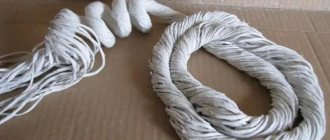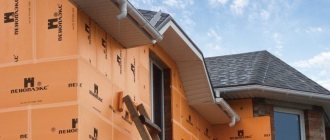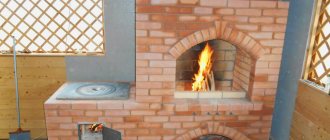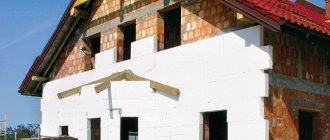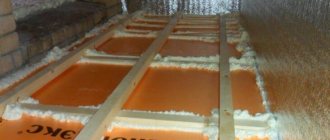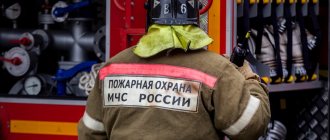Asbestos can be replaced:
| Analogs | Description |
| Asbestos fabric | It is woven from viscose, glass fiber, asbestos yarn. This is an ideal option for thermal insulation. This fabric is used for clothing for employees of production workshops working in high temperatures, and for firefighters. Asbestos fabric is an excellent way to insulate a stove or other heating appliances. The fabric will be very effective in extinguishing fires and substances that cannot burn without oxygen. This is a strong, durable, wear-resistant fabric that can protect well from fire without losing its characteristics at high temperatures. |
| Foam glass | It is a combination of two substances - fragile glass and weightless foam. The material is different:
This material loses the classic transparency of glass, but acquires good acoustic and thermal insulation qualities. It is so hard that you can drive a truck on it. It is often used for thermal insulation of load-bearing walls, pipelines, and basements. Despite its high rigidity, foam glass is easy to process. |
| Roll insulation | One of the most common and affordable insulation materials. Its base is mineral wool. Roll insulation comes in the form of:
Each insulation has its own characteristics and is an improved version of mineral wool. Glass wool is quite heat resistant, it can withstand temperatures up to 450 degrees. Basalt wool can withstand thermometer readings up to 700 degrees. Slag wool is less resistant to heat and can withstand up to 300 degrees Celsius. |
Asbestos is widely used for insulation of various structures. However, it is harmful to health, so people often wonder what can replace asbestos.
Today, several common materials are used for insulation, which are practically not inferior to asbestos in their characteristics, sometimes they are even better.
What can replace asbestos?
What can replace asbestos with similar characteristics?
Which slabs with the same characteristics will not contain asbestos? It is difficult to find a complete replacement for asbestos. The material is used in the food, pharmaceutical and construction industries, so to replace it you need to know where you want to use it. If you need a building material with similar heat-resistant properties, you can use a mineral basalt slab, thermal protection made of silica - Supersil or Vermoculite. Heat-resistant material is considered to be mullite-silica wool. In general, all mineral wools hold at least 700 degrees, but asbestos remains the cheapest material.
How to replace asbestos with similar characteristics when using facade slabs.
As I understand it, you want to replace asbestos-cement facade slabs with something similar in characteristics.
There are many options here, for example, not bad, fiber cement boards for finishing facades.
An absolutely environmentally friendly material, consisting of 90% cement and sand, the remaining 10% fiber (reinforcing material).
These slabs can be produced in various versions, that is, they look like something (for example, imitation stone, brick) or simply smooth.
The material not only does not support combustion, but is also a barrier to fire (like asbestos boards).
Thanks to the fiber, the slabs are durable and can withstand significant mechanical loads.
They are not afraid of temperature changes, UV radiation, and so on, that is, the properties are similar to asbestos boards, but at the same time environmental friendliness is at a different level.
The slabs do not rot, are not subject to corrosion, and are water resistant.
The price is quite affordable.
The choice of colors is simply huge.
It all depends on where you want to replace asbestos with more environmentally friendly analogues. In some cases, mineral wool will also work. But if you are going to use a substitute in more severe conditions, then you can use a new environmentally friendly material based on silicon. And indeed, silica can withstand temperatures of 1000 degrees. and thermal shocks up to 1700 degrees.
Basically, silica production is widely developed in China.
Asbestos can also be replaced with fiberglass. In laboratory conditions, I had to cover electric spirals with fiberglass. And the resulting stoves served well and maintained the temperature and isolated from electric current.
And finally, a new material is mineralite. Its slabs are used for facing fireplaces.
This material not only can withstand fire, but also protects against moisture.
It contains cement, mineral additives and special fibers.
Where is it used
If you study the question of what asbestos is needed for, you will notice that it is used in various fields, including industrial production and construction.
Construction
Unsplash
In installation work, its fire resistance and thermal insulation are especially valued. Therefore, very often when installing wall panels or laying floors, asbestos boards or wool made from the same substance are used.
Mechanical engineering and metallurgy
Cables and various metal and concrete structures are usually treated with this mineral in the form of spraying. This is how they acquire fire-resistant properties.
In addition, in some houses, cement pipes with the addition of this substance are installed. It is thanks to him that they become stronger and more durable.
Chemical industry
Asbestos has also found application in the chemical field, where it is used to make various plastics, paper and paint and varnish products.
Textile industry
Here this mineral is used in the manufacture of fabrics for workwear. It is used to make protective gloves, helmets and suits. In addition, brake flanges and pipe seals are also made with its addition.
- Construction Materials
7 harmful building materials that should not be in your home
Asbestos board? Asbestos cement? Or something else?
I'm remodeling an old kitchen, including 2 cabinets and a stove. On both sides of the stove there are bedside tables: T1-P-T2. I began to pull out the bedside tables and discovered that on the sides adjacent to the stove, gray sheets were nailed to the bedside tables with nails half a centimeter thick. I rummaged through my memory and assumed that it was asbestos. Or asbestos cement? Those. overheat protection.
While I was pulling out the bedside tables, I broke the slabs (Need to be replaced.
What should I replace it with? What to buy? Where is it sold, how much does it cost? You only need two sheets of 1m*60cm. I looked on the Internet - wholesale prices (Nails, screws? How to drill holes?
I looked in my area and couldn’t find anything like it in retail (
I would like some brief advice.
Zero answers. Pichalka
look in stores where materials for stoves, fireplaces, baths are sold
Zun wrote: I'm asking for some brief advice.
asbestos boards, etc. are considered not environmentally friendly, and it’s ugly. maybe it’s easier - stick in sheets of g/cardboard, slate is also suitable, cover the ends with U-shaped aluminum. profile. Well, this is, of course, if you are worried about the furniture, but it seems like if it stands with a gap, what will happen to it?
Samar wrote: asbestos boards, etc. are considered non-ecological. slates are also suitable
Illogical. Slate is an asbestos cement sheet.
What the hell is all this nonsense with this “overheating protection”? In millions of kitchens there is kitchen furniture of standard manufacture, which is now offered around every corner, without any “protection”, the necessary gaps are provided for by the design, the built-in appliances are generally adjacent without gaps. Who has “overheated” what?
I now also have a custom-made kitchen in my workshop. And before that it was homemade, according to the same T1-P-T2 scheme. It stood for 10 years without any asbestos. What was still missing was dragging asbestos into the house. In general, it is now prohibited for interior work; it is only used outdoors.
Profan27 wrote: Slate is an asbestos-cement sheet.
everything is true, but it is not the same thing. asbestos cardboard is quite fragile, crumbling and dusty; in slate, asbestos is bound with cement and is environmentally safe
, you can also adapt the DSP. You can paint it and it will be a designer slab.
Profan27 wrote: What the hell is all this nonsense with this “overheating protection”?
if the gas stove is old, then there is no thermal insulation on the sides and if the gap is small, then maybe. heating the chipboard until charring. Some customers are quite scrupulous and are wary when installing a kitchen.
What to put on the floor under the AOGV hot water gas boiler?
An AOGV gas boiler is installed in the kitchen.
Firefighters require that a sheet of iron or ceramic tile be placed underneath it. The size of the tile should be 75 by 60 cm. I can’t find such porcelain tiles anywhere. Moreover, if you assemble it from small tiles, then you need to put it on glue, and the base is plywood (since I prepared it for linoleum). I want to cut a hole in 12mm plywood and put a slab there, but then it turns out that the thickness of the tile is 15mm. Maybe you can come up with something else, please tell me? Best answer
Cut from ATSEID (aceite, aceid) to size. Sheets come in thicknesses from 6 to 40mm. I think firefighters will not be against asbestos-cement electrical arc-resistant boards. At least decorate it with mosaics)))
Other answers
You can screw GVL or GKL to your plywood in 2 layers. Place any tile on it with glue. Due to the height, you will get a podium. Cover the end of the podium with tiles as well. With good tiles, the podiums look very good.
I had the same problems, I made a podium from ordinary floor tiles in the color of Lenolium - it turned out great
Composition and types of asbestos-cement sheet materials
Asbestos cement is a common material that has been used for decades as roofing. It is durable, long service life, and weather resistant. Corrugated sheets are often called slate. A sheathing is constructed on the roof on which the roofing material is attached. The work does not require special knowledge or tools.
Asbestos cement board consists of:
- asbestos fibers;
- Portland cement;
- quartz sand.
Asbestos fibers increase the strength of the finished product and serve as a reinforcing material. Asbestos occupies up to 14% of the total mass of the panel. Cement of a grade not lower than M400 is a binder in an amount of 80% of the weight of the product. Fine sand is a filler and improves the characteristics of slate. Dyes can be added to the asbestos mixture for a more attractive appearance.
Roofing material is produced not only in corrugated sheets, it can also be flat. Flat asbestos cement is produced by pressing or without applying force. It is difficult to distinguish between pressed and unpressed sheets. Their differences lie in the characteristics of the material - pressed slabs are much stronger than non-pressed ones. The product sizes are the same.
Sheets with a wavy surface have long been used for roofing. Roofs of utility buildings and residential buildings are erected from them. Fences are made from the material, often cutting sheets are used to fence beds in private gardens.
Flat asbestos-cement products are produced in several sizes: length - from 250 cm to 360 cm, sheet width - 120-150 cm, thickness - from 0.6 to 1.0 cm. Corrugated sheets are available in sizes: thickness - 5.8-7.5 mm, width - 98 or 113 cm, length - 175 cm. Number of waves - 6, 7 or 8 with a height of 40-54 mm. These are standard sizes, which are sometimes violated, which is not prohibited by regulatory documents. For cladding walls and floors, tiles are produced in dimensions of 150x150x10 mm.
Roll insulation
When using roll insulation based on mineral wool, it is important to consider the surface and purpose of the material. Some options are best used for wood, others for brick or concrete.
It is also important to take into account the thickness of the base, temperature and weather conditions, especially if the insulation is external. Overall, this is a quality option with a lot of advantages.
There are many options for replacing asbestos. However, it is better to choose only proven, high-quality analogues. When choosing insulation, take into account its characteristics and the possibility of using it in certain conditions and the result will definitely please you.
Asbestos cement sheet - technical characteristics
- strength of wave sheets - 18 MPa;
- flat - 23 MPa;
- weight of wave material - 1.6 g/cm3;
- flat - 1.8 g/cm3;
- viscosity of the pressed product - 2.5 kJ/m2;
- unpressed - 2.0 kJ/m2;
- freezing and thawing of pressed slabs - 50 cycles;
- unpressed - 25 cycles.
Plates and sheets are resistant to corrosion, are not afraid of rotting, and resist UV rays and chemicals. When products are coated with waterproof enamel, they become resistant to water. Water absorption is comparable to glazed ceramic tiles.
Asbestos cement sheet - advantages and disadvantages of this building material
- strength;
- resistance to high temperatures;
- long service life;
- fire safety;
- ease of processing;
- moisture resistance;
- anti-corrosion and electrical insulating properties;
- sound insulation;
- saving money due to low prices;
- resistance to acids and alkalis;
- maintainability.
The strength of the sheet allows it to withstand the weight of an adult. When exposed to sunlight in the summer, slate does not heat up. Durability can be judged by roofs that are 50 years or more old. Asbestos cement is a non-flammable material, easily processed with hand tools: drilled, sanded and sawed.
Weaknesses in the characteristics of sheets:
- the appearance of moss on the surface;
- some difficulties when lifting sheets onto the roof;
- increased pressure on building structures;
- fragility of products.
When the ambient humidity is high, moss appears and grows on the slate. To prevent its appearance, finished products are treated with primers. The sheets are heavy, which makes lifting them onto the roof inconvenient. The covered roof has a strong impact on the wooden and brick walls of the building, the structural elements of the roof, so thicker and stronger rafters are needed. The slabs require care and attention when loading, unloading and storing due to their fragility.
Scope of application of pressed and unpressed asbestos cement material
Sheet asbestos cement of wavy shapes is used as a roofing material in the construction of roofs of residential buildings, agricultural buildings, and enterprise workshops. The construction of partitions and limiting the dimensions of garden beds cannot be done without them. Slabs with a smooth surface are used for cladding walls, floors and ceilings, balconies, loggias. Elements with smooth surfaces are used in the construction of internal walls in bathrooms, the production of sandwich panels, and formwork for concrete work.
When working with wavy or flat material, it is not recommended to pierce sheets with nails. It is better to drill them with a drill and tighten them with hardware through rubber or silicone washers. You cannot walk on slate; you need to lay walkways from boards. After cutting, the sections should be treated with acrylic paint, which will prevent the slab from crumbling. When purchasing a material, you need to choose it consciously and consult with professional builders.
Asbestos cement sheets. Scope of application, main characteristics and advantages
Asbestos cement sheets are one of the most popular products used in roofing and finishing works. The material is easy to process and has excellent technical characteristics. It is suitable for installing roofs, creating rough cladding, erecting partitions, leveling floors, and preparing surfaces for finishing.
There are two types of asbestos cement sheets on the market that have different purposes:
– flat pressed and unpressed;
Products with a flat surface are manufactured in two versions - pressed and non-pressed. There are no fundamental differences in color, thickness, or size between these materials. They differ from each other primarily in strength indicators: pressed products have higher strength than non-pressed ones, which is explained by significant compaction of the materials during the stamping process.
Corrugated asbestos-cement products are also divided into several types, the differences between which boil down to the shape of the profile:
Most asbestos-cement sheets are produced unpainted, but if desired, you can find aesthetically attractive products on sale, painted throughout the entire thickness or on the surface.
Scope of application
Corrugated asbestos cement sheets are used primarily as roofing material. This is a very budget-friendly and at the same time practical roofing option for a cottage, bathhouse, barn, garage and any other building.
Reinforced sheets are suitable for installation of enclosing structures during the construction of industrial and agricultural buildings.
Central European asbestos cement sheet can be used as wall or roofing material.
Products with a wavy profile have much higher decorative qualities compared to flat sheets, so it is preferable to use them for roofing.
Sheets with a flat surface can also be useful for creating roofs on small objects that do not have special requirements regarding appearance.
Unpressed flat sheets are used for finishing simple structures that do not experience special loads. With their help you can sheathe balconies, walls, partitions, ceilings. At agricultural sites, such material is used as flooring in chicken coops.
Advantages of asbestos cement sheets:
– high hardness and strength (the material can withstand the weight of a person);
– frost resistance (sheets do not crack at subzero temperatures);
– resistance to solar ultraviolet radiation;
– good thermal insulation properties (the sheet does not heat up in the sun);
– fire safety, non-flammability (does not ignite or smoke);
– ease of processing (simple tools are used for drilling and cutting);
– the material is not prone to corrosion and rotting (an advantage over wood and metal structures);
– affordable price (sheets cost significantly less than other roofing materials);
– good sound insulation (the roof does not make noise);
– resistance to chemically aggressive substances;
– the material does not accumulate static electricity and is a dielectric;
– unpretentious operation (no maintenance or expensive repairs required).
Disadvantages of asbestos cement sheets
Such a simple and inexpensive material has relatively few disadvantages, but you can put up with them. Sheets that are not covered with a protective composition quickly become overgrown with moss. The material is quite heavy, which makes it difficult to climb onto the roof when carrying out roofing work. You also need to take into account that asbestos cement sheets crack and break when dropped or hit. Products must be transported carefully, stacking them strictly in accordance with the requirements. Despite the fragility of asbestos cement sheets, you can walk on a roof with such a coating without fear of causing damage to the structure.
The service life of the material in question can be significantly extended by applying paint and varnish material. The presence of paint not only helps to improve the decorative and performance qualities of the material, but also prevents the release of asbestos fiber into the atmosphere. High-quality painted sheets are not affected by moss and become highly resistant to moisture.
How to install a wall-mounted boiler on a wooden wall?
Fire insulation device, distance from the wooden wall on which it will be hung? A wall made of rounded logs, how to fasten it? The logs move and give rise to sediment.
10/19/2009 at 19:45
Wooden unplastered walls and walls made of other flammable materials in places where gas-consuming equipment is installed should be insulated with non-combustible materials: plaster, roofing steel on an asbestos sheet with a thickness of at least 3 mm, etc. The insulation should extend beyond the dimensions of the equipment by 10 cm on each side and at least 80 cm above. something like this. As for shrinkage, if the house is less than a year old, a floating frame will save it. These are bars with longitudinal cuts. Nails are driven into the cuts - not with all their might. the house sits down - the nails float - the frame is in place.
10/19/2009 at 22:27
I understand about the floating frame.
“Roofing steel over an asbestos sheet with a thickness of at least 3 mm.” Either steel of at least 3 mm, or asbestos. I think they have. And yet, what does 3 mm belong to?
Instead of using roofing steel, can I simply plaster the boiler installation area?
I also read that the boiler to the flammable wall should be no closer than 10 cm. That is Should it be hung so that there is a gap of 10 cm between the boiler and the roofing steel?
Is it also necessary to insulate a log wall for an electric boiler?
10/19/2009 at 23:44
I wrote it off as normal
06/07/2015 at 06:48
Has anything changed in the rules for installing turbocharged boilers on a wooden wall? Of course, I bought some insulating sheets. On one side there is foil, and on the other there is some kind of crap like mineral wool or ceramic wool. The foil is kind of brittle. Size 60x100. I’ll attach one to the back of the gas stove, and put the second under the boiler. All this is for my own safety. And I’m interested in order to reduce the risk of “divorce” on the part of raygas workers. It's like firefighters, those same characters!
06/07/2015 at 09:48
Jack, Aceid leaf on the wall. Asbestos pipe through the wall.
06/07/2015 at 10:44
Kasimov, Is this also the case at Shilovsky District Gas? What kind of thermal insulation did I buy? Why an asbestos pipe? After all, I have a coaxial chimney and its outer part is not hot?
06/07/2015 at 11:50
Hang it on a sheet of flat slate that protrudes 10 cm beyond the perimeter of the back wall of the boiler. To prevent asbestos fibers from scattering from the slate, cover the surface with liquid glass.
The outer part of the coaxial pipeline cannot be hot. In winter, ice is more likely to form.
Suspend from the top points so that the slate does not break when the tree shrinks. Communications, naturally, must also be able to compensate for shrinkage.
06/07/2015 at 16:18
YOUNG, I’m not afraid of shrinkage. The log house, or rather the extension, is already more than 50 years old. And as far as I understand, no asbestos pipes are required?
06/07/2015 at 20:27
Galvanization with sheet asbestos. This is the most budgetary. Now stainless steel (transparent) also contains asbestos. Who cares. When the logs shrink, everything bends in waves. We fasten the aceid (flat slate) from the top. The boiler fasteners will press further. If
We attach the sheet from the heart!
Jack wrote: And as far as I understand, no asbestos pipes are required?
Smiled. Prove it to the firefighters! The minimum that is required is to wrap it in sheet asbestos.
YOUNG wrote: In winter, ice is more likely to form.
Jack, Condensation in coaxial chimneys is a big problem for some!
06/08/2015 at 10:31
Kasimov wrote: Galvanization with sheet asbestos. This is the most budgetary. Now stainless steel (transparent) also contains asbestos. Who cares. When the logs shrink, everything bends in waves. We fasten the aceid (flat slate) from the top. The boiler fasteners will press further. If we attach the sheet from the heart!
Smiled. Prove it to the firefighters! The minimum that is required is to wrap it in sheet asbestos.
Jack, Condensation in coaxial chimneys is a big problem for some!
A fireman is my friend's son and my son's friend. In order for condensate to flow out, the chimney must be made with a slight slope towards the street.
06/08/2015 at 19:17
I searched the entire Internet. The main conclusion: any heat-insulating material with a thickness of at least three mm can be placed under the boiler. But there are plenty of photographs on the Internet where the boiler hangs on a bare wall! Opinions vary about the coaxial chimney. They even claim that they are made of plastic, since their outside temperature is not much higher than room temperature. And therefore no additional insulation is required for them. I am aware that there are “local” realities. Related to the fact that some norms and rules were written under the Tsar Peas, and some of them contradict each other. Therefore, you will either have to adapt, or, having done everything wisely, you will still have to “get in the paw”!
What are asbestos cement sheets and what are they used for?
When constructing roofs, builders use various building materials as coverings. Sheets of wavy and flat shapes made from asbestos cement are widely used. However, asbestos cement sheets are in demand not only for roof construction. Technical characteristics allow the sheet material to be used for various purposes. Due to its increased density and strength, asbestos cement is used for the construction of fencing structures and installation of formwork. Asbestos cement sheets have an increased service life and are resistant to natural influences.
Foam glass
The material has many advantages over its analogues. The only disadvantages include high cost and low impact strength. However, these disadvantages are not critical and do not outweigh the advantages.
Foam glass can often be seen as backfill in wall cavities or as an insulating additive to concrete.
It is also used in industrial refrigerators and various equipment that operate at high temperatures.
Composition and types of asbestos-cement sheet materials
One of the most common building materials used in roofing work is asbestos cement sheet. The material is distinguished by a complex of properties, the main of which are sheet strength, durability, and resistance to external factors. The roof made of asbestos-cement building material is attached to the lathing; installation does not require special preparation. Asbestos cement sheets are known as slate.
The following components are used to produce sheet asbestos cement:
- asbestos fibers that increase the strength properties of sheets. Fibrous asbestos is used as a reinforcing material;
- Portland cement used as a binder. A cement composition marked M400 and higher is used;
- quartz sand. Fine sand is added to the composition as a filler to improve performance.
When performing roofing work, one of the most common building materials is asbestos cement sheet.
The concentration of asbestos fibers does not exceed 14%, and the proportion of cement reaches 80%. Sand is added according to the recipe. To give the sheets the required color range, the manufacturing technology allows for the introduction of special dyes or pigment additives into the working mixture.
According to the requirements of the current standard, the following types of slate sheets are produced:
- Flat asbestos cement sheets. The manufacturing technology of flat asbestos cement provides for the possibility of producing products by pressing, as well as without force. It is visually problematic to distinguish between a sheet obtained by pressing and non-pressed material. The varieties differ in their performance characteristics - pressed sheets are superior to unpressed slate in terms of strength and density. The dimensions of flat slate are standardized.
- Sheet asbestos cement with a wavy surface. Traditionally used for roofing activities. Roofs of residential and industrial buildings and commercial buildings are constructed from corrugated sheets. The material is also in demand for arranging fencing structures. The sheets differ in overall dimensions and number of waves. For roofing, six-, seven- and eight-wave slate sheets with different dimensions are used.
Protective screens for furnaces
Protective screens are structures used to insulate the side walls of furnaces. They reduce thermal radiation. Protective screens are made of brick and steel. Mostly such designs are used for metal furnaces.
Oven with metal protective screen
The easiest way to build a protective screen for a furnace with your own hands is from sheets of cast iron and industrial steel. Such screens are the most common. The sheets are installed at a distance of 1-5 cm from the walls of the oven.
Screens can be either side or front. There are furnace designs that do not require protective screens. They already have a special casing that reduces the intensity of thermal radiation.
Thanks to the use of protective screens, the temperature on the external surfaces of the structure reaches no higher than 100 °C . This significantly increases fire safety and reduces the distance from the screen to the wall of the room to 50 cm. Taking into account the gap between the screen and the oven wall, the safe distance does not exceed 55 cm. Protective screens are convenient and easy to install. With the help of special legs they are securely attached to the floor.
Asbestos cement sheet - technical characteristics
When planning to use asbestos cement sheet, the technical characteristics should be carefully studied.
Main product indicators:
- ability to withstand bending loads. The strength indicator varies from 18 MPa for corrugated material to 23 MPa for flat asbestos cement;
- specific gravity. The density of the sheets differs depending on their type and is 1.6 g/cm³ for sheets with a wavy surface, and 1.8 g/cm³ for flat material;
- impact strength coefficient. Asbestos cement obtained by pressing has the highest value, equal to 2.5 kJ/m². The unpressed material has a reduced impact strength value of 2.0 kJ/m²;
- ability to maintain integrity under the influence of temperature changes. The pressed material is capable of withstanding at least 50 cycles of deep freezing with further thawing. For other types of sheet cement, the figure exceeds 25 cycles.
The residual strength for all types of sheets is at least 90 percent.
Before using asbestos cement sheet, you should carefully study the technical specifications
Asbestos cement sheet - advantages and disadvantages of this building material
Like any building material, sheet asbestos cement has a number of advantages and at the same time has certain disadvantages.
First, let's look at the main advantages of asbestos-cement sheets, which include:
- strength. A hard and dense sheet of asbestos cement maintains its integrity, accepting the mass of a person;
- resistance to elevated temperatures. The material retains its performance properties and practically does not heat up when exposed to sunlight;
- long period of use. The durability of the material is evidenced by the roofs of buildings covered with slate more than half a century ago;
- Fire safety. Asbestos-cement material does not ignite when exposed to open fire and has fire-resistant properties;
- ease of machining. There is no need to use special tools and equipment to cut sheets to size;
- moisture resistance. Asbestos-cement slate reliably blocks the path of precipitation and maintains performance characteristics when used in conditions of high humidity;
- anti-corrosion properties. Asbestos cement is not susceptible to corrosion and is superior in this indicator to roofing materials made of metal;
- electrical insulation characteristics. The material is a good insulator and does not conduct electric current, ensuring safety in case of wire breaks;
- noise insulation properties. Asbestos cement material absorbs sounds from hail and other precipitation on slate roofing;
- affordable price. Compared to other types of roofing materials, slate is much cheaper, which allows you to save money;
- resistance to aggressive liquids. The material is resistant to alkaline environments and does not break down when in contact with acid;
- maintainability. If asbestos-cement roofing elements are damaged, it is easy to carry out repair measures by replacing individual sheets.
Asbestos-cement material is durable.
Along with its advantages, slate also has its weaknesses:
- in conditions of high humidity, the surface is gradually covered with moss;
- to lift massive sheets it is necessary to exert considerable effort;
- heavy sheets exert increased pressure on the roof structure;
- The fragile material requires careful handling during transportation and installation.
To increase the moisture resistance of the material and prevent the development of moss, special primers are used. To ensure the reliability of the roof structure, beams of increased cross-section are used, which are reinforced at the joints with metal plates.
Scope of application of pressed and unpressed asbestos cement material
Thanks to a set of serious advantages, asbestos cement sheets are widely used in roofing work, as well as for solving other problems. Let us dwell in more detail on the use of sheet building materials.
Regardless of the method of manufacturing asbestos-cement sheets and their varieties, the material is used to solve a wide range of problems:
- roof structures in residential and public buildings;
- roofing installations at enterprises and agricultural facilities;
- construction of fencing structures in the industrial sector;
- protective and decorative cladding of loggias and balconies;
- external cladding of walls of various buildings;
- production of partitions in sanitary premises;
- forming screed using dry technology;
- production of external sides of sandwich panels;
- construction of panel formwork elements;
- formation of dividing partitions indoors.
Despite the expanded scope of use of the material, the traditional use of asbestos-cement slate is to create blood. Sheets with a wavy profile are more often used for arrangement. They look better on the roofs of houses and provide more efficient precipitation drainage compared to flat asbestos cement.
Application in the modern world
The widespread use of the mineral these days has been ensured due to its unique qualities: high fire resistance, strength, elasticity, and resilience. The material is widely used in construction, aircraft and shipbuilding. He is involved in the production of:
- facade slabs;
- thermal insulation materials;
- sealants;
- roofing products;
- wall products;
- rubber products;
- asbestos products;
- bricks;
- finishing materials (liquid asbestos).
Let's sum it up
Asbestos-cement sheets are popular in the construction industry, the technical characteristics of which allow the material to confidently compete with other types of roofing building materials. In specialized stores, sheet asbestos cement is presented in an expanded range, which makes it easier to select the required assortment of asbestos cement to solve specific problems. When purchasing sheets, decide on their standard size and, if necessary, consult with professional builders.
Sources:
https://www.remotvet.ru/questions/13338-chem-mozhno-zamenit-asbest.html https://mastergrad.com/forums/t172653-asbestovaya-plita-asbocementnaya-ili-chto-to-eshche/ https ://1beton.info/vidy/asbestocement/asbestocementnye-listy https://garant-torg.ru/asbestotsementnye-listy-sfera-primeneniya-osnovnye-harakteristiki-i-dostoinstva/ https://pobetony.expert/poleznye- stati/listy-asbestocementnye

